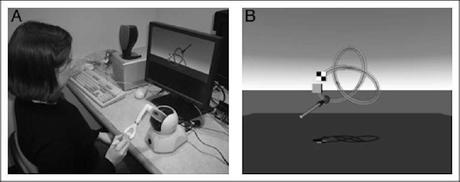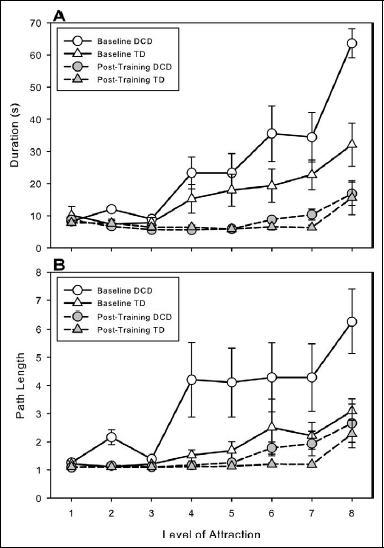One key question about DCD is why does it occur. Part of the problem in answering this is that it is a behavioural diagnosis; you get diagnosed if you have severe motor impairments that aren't a known side effect of something else. Regardless, there are two basic ways in which children might end up with such problems; crudely, they might have difficulties in producing movements, or they might have difficulty learning movements. My colleague and author on this paper, Mark Mon-Williams, uses the analogy that children with DCD may be bad drivers of perfectly working cars or good drivers of malfunctioning cars. It's obviously a little messier than that, but this is the essential idea, and the answer has implications for the kind of interventions you'll try and design.
When I post-doc'd with Mark, I did research with children with DCD and was peripherally involved in the pilot testing of the robots used in this paper. I made a prediction at the time: I bet that children with DCD are bad drivers and don't have a learning problem. I based this on two observations. First, occupational therapists do succeed in helping these children learn skills the children want to learn, such as riding a bike. It's hard, it takes time, but it's doable. Second, in our experiments I saw that the children were moving poorly, but always in a manner that made perfect sense if you assumed they were producing movements that matched their skill level. One study asked children to reach and grasp and turn a dowelling, and the task was set up that you could sometimes choose to make an initially difficult reach in order to end up with a comfortable end posture after the turn. The children with DCD almost always chose to do the first movement as easily as possible, and just suck up the costs later on (van Swieten et al, 2010). They weren't planning ahead for the turn part, as skilled reachers do; they were just coping with having to make a reach first. This always struck me as evidence that children with DCD were learning just fine; but what they were learning, without help, was to make the best of their not very good action systems.
The question is - can we help them to do better? Therapy works but it's time consuming and costly and there aren't enough hours in the day, let alone occupational therapists in the health service. One increasingly common solution is robots; have them provide assistance and let the therapist run a room with 20 of them at a time. The pilot work I mentioned had tested a robotic system and a game to practice fine motor control of the hand, and we'd shown that the idea was sound and that the kids were motivated to stick with it. The remaining question - what do you get the children to do?
Snapp-Childs, Mon-Williams & Bingham (2012) had 8 children with DCD (aged 7-8) play a simple video game using a Phantom Omni force feedback robot. The game had the children use the stylus to control a fish on the screen, and move it around a three-dimensional track in a race with a computer controlled fish. The track, via the robot, exerted a 'magnetic pull' on the children's hand; if you started to move off the track, the robot would pull you back onto it. This magnetic effect helps keep you on the path, and, importantly, the strength of the pull can be varied systematically to provide more or less assistance.

Figure 1. (A) Example of display and target path. (B) The Phantom together with the display.
They then varied the amount of magnetic pull until they found a level of assistance at which the children with DCD were performing just as well as the typically developing controls. At Baseline, they measured performance across a range of assistance levels from this comparable level to very little assistance. The two measures were how long it took to complete the path and the normalised path length (where anything greater than 1 suggests time spent off the target path). Predictably, the children with DCD got worse faster than the controls (white symbols in Figure 2).Training started at the level of assistance where performance was equal across the groups, and the children worked their way up through three levels of task difficulty (speed of the competitor fish, length of the path, and level of magnetic attraction). The difficulty was increased when the child had won 2 races in a row, and training took place in up to 5 sessions, each separated by a week. They then repeated the Baseline assessment at Post-Training (filled symbols in Figure 2).

Figure 2. Duration (a) and normalised path length (b) data. Level 1 of 'attraction' is the most assistance, 8 the least
The results were straight-forward. The children with DCD started out getting hit hard as the magnetic help went away. Over time, they learned to successfully produce fast and accurate tracings of the tracks without that assistance.Why does this work?
To learn a new motor skill, you have to first be able to produce something that's in the ballpark. Only then can you start to fine tune the movement, making it more efficient and stable. Even newborn babies don't start as blank slates; they come equipped with a repertoire of spontaneous movements that serve as a foot in the door of this problem. Children with DCD seem to have problems with this initial step; they produce unstable and therefore highly variable movements to begin with, and there's not enough 'signal' in amongst the 'noise' for a learning process to hone in on.
The robot helps them through this initial Catch-22, by helping them produce stable and repeatable movements. What's important is that the children with DCD can then capitalise on this help and learn enough to not need the help all the time. This suggests that children with DCD do not have a learning problem.
An important part of this study was the ability to carefully step the task difficulty up by reducing the amount of assistance over time. This meant that the children were continually asked to actively pick up more and more of the responsibility and not simply come to depend on the robot. In addition, the task required the children to always actively produce their own movements; the robot never simply dragged them around the track. The active production of movements is an important part of creating an action a learning system can tune in to (Bingham, 1988 + a wide literature on active vs passive training, including an upcoming follow-up from this research group).
Summary
I like this work; I get a kick out of having been right in my prediction and this is basically the study I wanted to run sometime. My only beef is that Geoff beat me to it :)
This study also demonstrates an important point in this time of funding fun and games. Robotic systems are excellent and have the potential to resolve many resource bottlenecks in the health services, but you have to know what to have the robots do with the patients. This is why basic research on motor control and learning is crucial; the kids have fun playing with the systems, which is great, but if they aren't doing anything useful then there's no point.

van Swieten, L. M., van Bergen, E., Williams, J.G.H., Wilson, A. D., Plumb, M.S., Kent, S. W., & Mon-Williams, M. (2010). A test of motor (not executive) planning in developmental coordination disorder and autism. Journal of Experimental Psychology: Human Perception and Performance, 36(2), 493-499. Download

